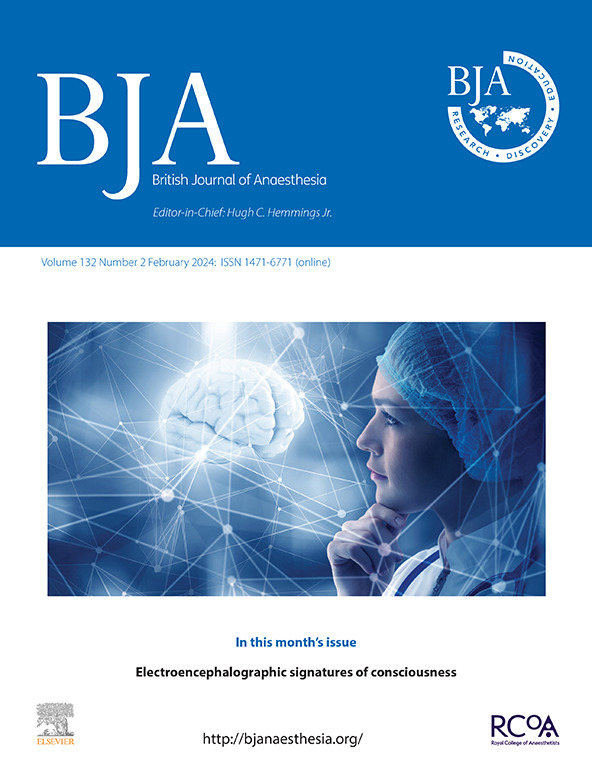Accuracy of continuous glucose monitoring during noncardiac surgery: a prospective, blinded observational multicentre cohort study.
IF 9.1
1区 医学
Q1 ANESTHESIOLOGY
引用次数: 0
Abstract
BACKGROUND Hyperglycaemia after noncardiac surgery is rarely detected outside of the critical care environment, yet occurs commonly and is associated with excess complications including infections and myocardial injury. Systematic, prospectively collected data regarding the accuracy of continuous glucose monitoring commenced immediately before surgery and throughout the early perioperative period are lacking. METHODS We prospectively enrolled patients aged >50 yr undergoing noncardiac surgery who required at least 24 h of hospital stay. We used real-time continuous glucose monitoring (Dexcom G7 sensor, placed in the upper outer arm) (Dexcom, San Diego, CA, USA) with reference values from arterial blood glucose measurements by amperometry. The primary outcome was the overall mean difference (bias) before surgery, at end of surgery, and 24 h after surgery (Bland-Altman analysis). Secondary outcomes included the mean absolute relative difference and surveillance error grid analyses. RESULTS We compared paired blood (73% arterial) and continuous glucose monitoring glucose values at each prespecified timepoint in 118 participants (64/118 [54%] female; mean age: 66 [range: 51-89] yr; 25% with diabetes mellitus). The overall bias between continuous glucose monitoring and blood glucose from measurements at each of the three timepoints in the first 24 h after induction of anaesthesia was 0.38 mM (95% confidence interval [95% CI]: 0.23-0.53; n=340 paired readings). Bias decreased from before the start of surgery (1.08 mM [95% CI: 0.87-1.29]; n=116) to 0.15 mM at the end of surgery (95% CI: -0.15 to 0.46; n=113). Mean absolute relative difference ranged from 12.0% to 18.3%. Error grid analyses found that >98% continuous glucose monitoring values were within acceptable risk ranges. CONCLUSIONS The accuracy of state-of-the-art continuous glucose monitoring is sufficient for perioperative use and could enhance perioperative surveillance of dysglycaemia. CLINICAL TRIAL REGISTRATION ISRCTN46862025.非心脏手术期间连续血糖监测的准确性:一项前瞻性、盲法观察多中心队列研究。
背景:非心脏手术后高血糖在重症监护环境之外很少被发现,但却很常见,并与感染和心肌损伤等并发症相关。关于术前和围手术期早期开始的连续血糖监测的准确性,缺乏系统的、前瞻性的收集数据。方法:我们前瞻性地纳入年龄在bb0 ~ 50岁、接受非心脏手术且住院时间至少24小时的患者。我们使用实时连续血糖监测(Dexcom G7传感器,放置在上臂外臂)(Dexcom, San Diego, CA, USA),参考动脉血糖测量值。主要结局是术前、术后和术后24小时的总体平均差(偏倚)(Bland-Altman分析)。次要结果包括平均绝对相对差和监测误差网格分析。结果:我们比较了118名参与者在每个预定时间点的配对血(73%动脉)和连续血糖监测的血糖值(64/118[54%]女性;平均年龄:66岁[范围:51-89]岁;25%患有糖尿病)。连续血糖监测与麻醉后前24小时三个时间点测量的血糖之间的总体偏差为0.38 mM(95%可信区间[95% CI]: 0.23-0.53;N =340对读数)。偏倚从手术开始前开始下降(1.08 mM [95% CI: 0.87-1.29];n=116)至手术结束时0.15 mM (95% CI: -0.15至0.46;n = 113)。平均绝对相对差为12.0% ~ 18.3%。误差网格分析发现,bb0 - 98%的连续血糖监测值在可接受的风险范围内。结论最先进的连续血糖监测准确度足以满足围手术期的使用,并能加强围手术期血糖异常的监测。临床试验注册号:rctn46862025。
本文章由计算机程序翻译,如有差异,请以英文原文为准。
求助全文
约1分钟内获得全文
求助全文
来源期刊
CiteScore
13.50
自引率
7.10%
发文量
488
审稿时长
27 days
期刊介绍:
The British Journal of Anaesthesia (BJA) is a prestigious publication that covers a wide range of topics in anaesthesia, critical care medicine, pain medicine, and perioperative medicine. It aims to disseminate high-impact original research, spanning fundamental, translational, and clinical sciences, as well as clinical practice, technology, education, and training. Additionally, the journal features review articles, notable case reports, correspondence, and special articles that appeal to a broader audience.
The BJA is proudly associated with The Royal College of Anaesthetists, The College of Anaesthesiologists of Ireland, and The Hong Kong College of Anaesthesiologists. This partnership provides members of these esteemed institutions with access to not only the BJA but also its sister publication, BJA Education. It is essential to note that both journals maintain their editorial independence.
Overall, the BJA offers a diverse and comprehensive platform for anaesthetists, critical care physicians, pain specialists, and perioperative medicine practitioners to contribute and stay updated with the latest advancements in their respective fields.

 求助内容:
求助内容: 应助结果提醒方式:
应助结果提醒方式:


